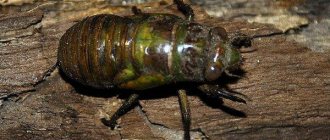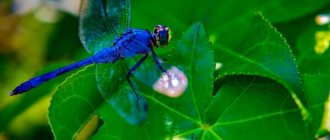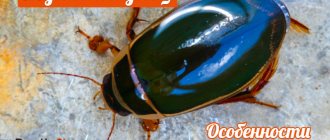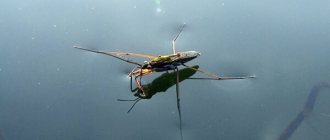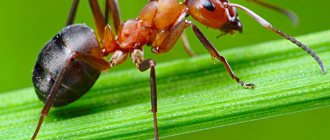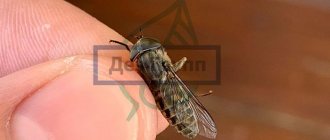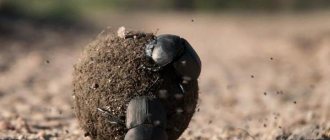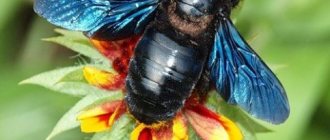Taxonomy [ edit | edit code]
In 2022, a revision of subfamilies and tribes was carried out, including the identification of 10 new tribes and the restoration of the subfamily Tettigomyiinae.
Cicad >Latreille, 1802
Cicadettinae Buckton, 1889
Tribes: Carinetini Distant, Chlorocystini Distant, Cicadettini Buckton, Dazini Kato, Hem >Latreille, 1802
Tribes: Burbungini Moulds, Cicadini Latreille, Cryptotympanini Handlirsch (=Tacuini Distant), Cyclochilini Distant, Distantadini Orian, Dundubiini Atkinson, F >Distant, 1905 (n. stat., 2018)
Tribes: Lacetasini Molds & Marshall, 2022, Malagasiini Molds & Marshall, 2022, Tettigomyiini Distant, 1905, Ydiellini Boulard, 1973.
Tibicininae Distant, 1905
Tribes: Chilecicadini Sanborn, 2014, Platypediini Kato, 1932, Selymbriini Moulds & Marshall, 2022, Tettigadini Distant, 1905, Tibicinini Distant, 1905.
Ordinary
You can meet the common cicada along the entire Black Sea coast, in the Mediterranean and in the Caucasus. Since the main habitat of insects is thickets of bushes and trees, it is almost impossible to detect these cicadas in a meadow or steppe.
Appearance. These are quite large insects, reaching a length of 3.5 centimeters, and taking into account the wings - 5-6 centimeters. Cicadas have a black and gray body color, a wide head with two bulging eyes on the sides and three small eyes in the center. There is a vague yellow or orange pattern on the back.
Common cicada - photo:
What harm does it cause? Like all other cicadas, this species feeds on plant sap at all stages of development, making small punctures in the leaves and bark. Females lay eggs in cuts in the bark, and the grown larvae, falling to the ground and burrowing into it, destroy young roots.
Most often, the common cicada is found in vineyards.
additional information
Cycad insects make certain sounds for a reason. The characteristics of the chirping depend on the purpose. Basically this is a call for procreation. The female sings much more quietly than the male. Flies can live both in bushes and in the foliage of trees.
They fly very well and it is almost impossible to catch them. Although many fishermen manage to get cicadas for a better catch. The insect's singing attracts fish. Despite the fact that the creature does not look very attractive, it is highly valued and is even used as food. Thus, side dishes are made from flies in Asia and Africa.
All this is due to the nutritional value of representatives of this species. They contain a significant amount of protein and virtually no calories. They taste like boiled potatoes, so they are not disgusting.
Many people will be interested in knowing how long cicadas live. Their lifespan is about 17 years, depending on the species. Flies feed mainly on sap, which is extracted from plants. They damage the bark with their sharp proboscis and suck liquid from the pulp.
However, it should also be said about the damage that representatives of this species often cause. Agricultural plantings are most often affected. When exposed to flies, a small white spot appears on the plant, which gradually grows. As a result, the crop dies, its stem becomes weak and lifeless.
The larvae of these representatives live exclusively underground, where they can remain for a long time. They feed on sap that they suck from the roots of plants and trees. Before emerging into the light, they build special tunnels. The so-called intermediate stage of nymphs - the transition to an adult - occurs directly on the trees. For final formation, the larva remains on the leaf for about a week, being motionless.
Nutrition
The feeding peculiarity of cicadas is such that in many countries they are considered parasitic insects. Vineyards, garden plants and trees suffer from their invasions. Adult cicadas damage stems, branches, and leaves with their proboscis, extracting the desired juice from them.
Having been saturated, they are removed, and life-giving moisture continues to flow from the “wound,” gradually turning into manna - a sticky, sweetish substance (medicinal resin). Cicada larvae living in the soil damage the roots as they suck out the liquid from them. The degree of their danger to agricultural crops has not yet been established.
Because of their powerful mouthparts, cicadas can “suck out” and damage even plant tissue located deep inside. As a result, after such feeding, crops may die. In agricultural areas where there are many cicadas, farmers often notice a drop in yield. Both larvae and adults can be dangerous.
Biology [edit | edit code]
Habitat
Cicadas are mostly large insects found in all parts of the world, mainly in hot countries. They live in trees and bushes and fly quite well.
Chirping
Males chirp or sing mainly during the hottest time of the day, since heat is an important source of energy, which the cicada spends on singing. However, recently, scientists are finding more and more cicadas chirping in the shade or during twilight in order to protect themselves from predators. Among them, the cicadas of the genus Platypleura
.
Most Platypleura
warm themselves by contracting muscles specialized for flight. The singing of male cicadas serves to attract females.
Cicadas use a special sound membrane that is vibrated by muscles. The resulting metallic sound resonates in special cavities inside the body, reaching great volume. The South American cicada is capable of making a sound similar to the whistle of a steam locomotive. The females of many species of cicadas do not chirp, but this is not true for all.
Nutrition
With the help of a proboscis (and the female also an ovipositor), cicadas inject into various trees and suck out their juices. Often the tree sap continues to flow even after the cicadas prick and, hardening in the air, forms the so-called manna, which is a nutrient.
Life cycle
Cicadas lay eggs under the bark or skin of plants. The larvae are distinguished by a thick, clumsy body, a smooth and hard cuticle, and thick legs with single-jointed tarsi; forelegs with wide hips and shins covered with spines (a type of burrowing limbs). Young larvae first suck plant stems, and at later stages of development they lead an underground lifestyle and suck plant roots. The larvae live for several years (sometimes up to 17 years), although for most species the duration of larval life is unknown. After numerous molts, the larvae develop rudiments of wings; The last molt is usually done on trees.
Periodical cicadas may be a result of the Ice Age
The main hypothesis to explain why there are both annual and periodical cicadas, and why the lifespan of periodical cicadas is different, is that some broods located east of the Great Plains in the US alone developed extremely long juvenile stages during the Ice Age Pleistocene ().
That northern broods tend to stay underground longer than southern broods in the US supports this theory. However, critics say it makes no sense that glaciation only affected cicada populations in a certain area, since other cicada habitats were similarly covered in ice.
Their tendency to appear only in prime cycles is thought to be an attempt to prevent predators from feeding on them repeatedly ().
In culture[edit | edit code]
There is a mention of cicadas in the oldest surviving monument of Greek literature - in Homer's Iliad (
XI-IX centuries BC e.). The ancient Greeks greatly appreciated their singing, and Anacreon is known to have written an ode in honor of the cicadas. Cicadas are actually mentioned in Aesop’s fable “The Grasshopper and the Ant” and La Fontaine’s fable “The Cicada and the Ant”, which in turn is a loose translation of Krylov’s fable “The Dragonfly and the Ant”. According to ancient Greek mythology, the goddess Eos turned her aged husband Tithon into a cicada, whom she kidnapped as a young man, captivated by his beauty.
In the countries of the Far East and China, the cicada is considered a summer insect and hides in the ground during winter hibernation. Buddhist sages saw in this system similarities with how a human being is reborn through death, passing from one body to another. In the ancient Chinese tradition, there is a ritual when a jade cicada is placed under the tongue of the deceased in the mouth. This, according to legend, should help him find a worthy embodiment in a new life and allow him to talk in the afterlife. This tradition still exists both in its original form and slightly modified, when a cicada is placed on the body of a deceased person. In Japan, cicadas were associated with summer and the transience of life; They were often depicted in engravings, and poets dedicated poems to these insects.
The cicada is one of the heroes of Victor Pelevin’s novel “The Life of Insects.”
In the book "The Pillars of Creation" by Terry Goodkind, cicadas are mentioned in one of the prophecies, which speaks of their 17-year life cycle.
300 jewels, supposedly in the shape of cicadas (called "golden bees"), were found in the tomb of the first Frankish king, Childeric I (died 482 AD).
Chinese artist Qi Baishi (1864-1957) has a painting called “Autumn Cicada on Lapin Flowers.”
US folk and pop singer Linda Ronstadt glorifies the life of the cicada in the song “La Cigarra”, and at the same time hints at their short life.
There is also a ballet by French composer Jules Massenet, La Cigale.
There is also an animated series “When the Cicadas Cry,” where in each episode the action is accompanied by the drawn-out song of the cicadas.
Fun fact: Many anime series use footage of cicadas.
In the Russian translation of the game The Last of Us, cicadas are a group that opposes the military and plays a major role in the game.
Coin from Ancient Greece: Athena on the left, an owl on the right and a singing cicada sitting under the wing on the bottom left
Coin from Athens: location with cicada indicated
Golden bees (cicadas) inlaid with garnet from Childeric's tomb
A cicada is an insect somewhat similar to a fly, only very large. Especially with its large transparent wings, folded at rest on the sides of the body. But this is not a fly or a beetle. It's just a cicada - the longest-living insect in the world.
A cicada is an insect somewhat similar to a fly, only very large.
Musicians by nature
Most people don't usually think about how cicadas make sound, which is why the expression "singing insect" has caught on in everyday life. In fact, it would be more accurate to call these creatures musicians, because they do not sing or chirp, but play music on their “cymbals.”
All male cicadas have an original device in the lower part of their abdomen in the form of two symmetrical convex membranes, which, under the action of muscles, can be retracted inward, and when relaxed, return to their original position. The sound from these back-and-forth movements of the cymbal organs resonates in special cavities inside the body and turns into the music of the cicadas.
Humanity often encounters these insects because of their prevalence on our planet, and therefore there are all sorts of attitudes towards them:
- someone listens to them with pleasure;
- farmers and gardeners fight with them for the harvest;
- residents of China, Burma, Congo and almost all of Latin America eat them with relish (deep-fried cicadas are considered a real delicacy here);
- in some places they are used as souvenirs, music boxes and toys (for example, in Provence) and used as a symbol.
To briefly outline who cicadas are, it would probably be correct to call them amazing creatures that leave few people indifferent.
Description and features
Most cicadas have a body length of no more than 36 mm, and if measured with folded wings, then about 50 mm. The antennae with a flagellum are most often quite short. The lower surface of the front femurs is decorated with two large teeth.
On the head of song cicadas, between the large compound eyes, there are three more simple eyes. The proboscis is long and can easily cover the length of the entire chest.
Males have a well-developed apparatus for making very loud sounds. During the mating season, which can last several weeks, the volume of their singing can be comparable to the noise of a train passing on the subway and is expressed at 100-120 dB, which allows us to call them the loudest insects on our planet. The color of common cicadas is predominantly black or gray, the head and front back are decorated with intricate yellow patterns.
The larvae are usually no larger than 5 mm in size and do not resemble their parents. They have powerful front paws, which they use to dig into the ground to protect themselves from the winter and undergo further development into a nymph. They are distinguished by a light body, but the specific color depends on the species and habitat.
The winter cicada is never an adult - due to the fact that they do not live long, individuals that survive metamorphosis die even before the first snows. All that remains are the larvae, burrowing deep into the ground, and the nymphs, waiting for warm days to begin pupation.
Therefore, further we will talk only about the larvae. The habitat of the common cicada is considered to be the Mediterranean and the Crimean Peninsula. These insects are also common in the Caucasus region and Transcaucasia.
The most impressive of all cicadas can be called the Royal (Potponia imperatoria), which is considered the largest on the planet. Its body length is 65 mm, and its wingspan is 217 mm. These giants are found in peninsular Malaysia and Singapore.
The coloring of the royal creatures resembles the bark of a tree, on which the cicada insect spends most of its terrestrial life. Transparent wings also do not spoil the camouflage, so it is really difficult to notice such a large creature.
Singing cicadas prefer regions with hot and humid climates. Therefore, about 1,500 species can be found in the tropics. In Europe, 18 species of these insects are widespread. Some of them are very numerous. Cicadas are permanent residents not only of Eurasia, Indonesia, but also other places; accordingly, their species differ:
1. Green cicada. It is found everywhere in China, Kazakhstan, the USA, most regions of the Russian Federation and many countries of Western Europe. They live mainly in swampy areas, in flooded or wet meadows, where a lot of lush grasses and sedges grow. The wings are greenish, the body is yellowish, and the abdomen is blue-black. Considered a pest. Cereals are especially affected by green cicadas.
2. White cicada - metalkafa or citrus. Grayish in color with a whitish tint, length no more than 9 mm, the insect, together with its wings, has an elongated shape. It looks a little like a drop, even like a small moth.
It's hard to believe that the fluffy growths that appear on plants in mid-spring are living metalcaf larvae that cause damage to agricultural plants.
3. Buffalo cicada or humpback cicada. Above their head is a peculiar growth that gives this species its name. It parasitizes green grape stems, in which it hides eggs, after cutting the shoot bark with the ovipositor, which causes the damaged stems to die.
4. Mountain cicada. Distributed in China, the USA, Turkey, Palestine, and also found in large quantities in the Far East and Southern Siberia. Its body is about 2.5 cm long, very dark, almost black, its wings are thin and transparent.
5. Ash cicada. It is half the size of an ordinary one. Entomologists classify it as a member of the songbird family. The name comes from the manna ash tree, whose branches insects chose to lay eggs. The body dimensions of individual specimens reach 28 mm, the wingspan is up to 70 mm.
On the thick, almost transparent abdomen, reddish segments and small hairs are clearly visible. There are brown dots on the veins and surfaces of the wings. They feed only on sap, which is extracted from plants and young branches of bushes. They prefer olives, eucalyptus, and grapes.
Unique periodic cicadas (Magicicada) from North America, whose life cycle is 13 and 17 years, are also classified as songbirds. They differ in that they degenerate en masse into adults. The insects are sometimes given a unique nickname - “seventeen-year-old locust”. But they have nothing to do with locusts.
Varieties
There are 2,500 species of cicadas in total, and all differ only in size and color. The most famous family are the song or true cicadas. There are more than 1,500 species. The most notable of them:
- regal - the largest in size, since its body length reaches 6.5 cm, and its wingspan up to 18 cm, it is mainly common in Indonesia;
- oak - the length of its body is 4.5 cm, most often they live in the forests of Russia and Ukraine;
- common - body size 5 cm, lives on the Black Sea coast and at the height of the holiday season you can often hear its singing;
- mountain - is the smallest representative of this species, since the body length is only 2 cm, chooses cooler areas for living;
- periodic - lives in the vastness of North America and is distinguished by its long development cycle (17 years), at the end of which a large number of offspring appear.
Song cicadas have special organs for singing - cymbals . With their help, insect singers produce melodic sounds. The organ looks like membranes located on the abdomen of males. Thanks to special muscles, it tenses and relaxes them. This mechanism is equipped with cameras to amplify sound. A special chamber opens when sound vibrations occur. This allows you to hear the melody at a distance of up to 900 meters. The most powerful sounds can be made by southern song cicadas.
In addition to singing insects, other types of cicadas are also widely found in nature:
- dark;
- striped;
- grape;
- six-point;
- potato;
- club-shaped;
- Rosenaya
All species are very similar to each other and differ slightly in the characteristics of reproduction, structure, character and nutrition.
How to fight a cicada
To preserve the harvest and avoid losses associated with the harmful effects of cicadas on garden and field crops, several control methods can be used. They are universal, since different families of these insects have similar biological properties.
Safe ways to fight
- Timely removal of cereal carrion is one of the most effective preventive measures, since the development of these insects occurs precisely in this environment. To do this, it is necessary to peel the soil at an earlier date. Then, after 15–20 days, the first shoots of carrion will sprout. After plowing, the eggs and larvae of cicadas completely die.
- The same is done with any plant residues as a source of food for pests. It is necessary to dispose of them in a timely manner - collect, transport, burn. Moreover, if leaves and other types of vegetation have already been affected.
- The period of development of larvae and young individuals coincides with the sowing time of winter crops. Therefore, it is better to push back the timing of their sowing as much as possible. The same applies to late spring types of cereal crops. As a result, the biological development cycle of insects will be interrupted.
- To protect garden crops, it is necessary in the fall, after harvesting, to dig up the soil around fruit trees: the eggs and larvae of many types of cicadas overwinter in the soil. Pests raised to the surface will be destroyed either by the first frost or by birds feeding on them.
- Helping the natural enemies of pests in our gardens - birds - it is quite natural to organize feeding for them by arranging feeders.
Chemical control methods
Preventive measures alone are usually not enough to completely control the reproduction of cicadas over the entire area of large fields and vegetable gardens. It is necessary to use pesticides that destroy a fairly wide range of pest species.
It is important not to forget about safety precautions when using these chemicals that can harm human health. The use of insecticides such as “Fastak” and “Karate 050 EC” of contact-intestinal action is effective against cicadas
The use of insecticides such as “Fastak” and “Karate 050 EC” of contact-intestinal action is effective against cicadas.
After two spraying cycles, carried out with a break of 10 days, the pest was completely
disappears. The harvest can be harvested 20 days after the last treatment with the Karate 050 EC insecticide. The first of the drugs is not accompanied by such restrictions: if the indicated doses are used correctly, it does not have a harmful effect on plants.
The marginal strips of seedlings of winter cereal crops infected with cicadas are usually treated at a concentration of 55 to 145 individuals per square meter of area. It is not difficult to detect adult insects.
The principles of pollination in vegetable gardens are the same.
This work is carried out in a windless evening. A sprayer is used for treatment; a broom cannot be used.
- You only need to prepare the required amount of working solution, since it is prohibited to store it.
- Depending on the area to be pollinated, you need to dissolve the amount of insecticide indicated on the package in 1 liter of water and filter the resulting solution.
- Place half of the total specified volume of water in a large container. Then pour the prepared solution into it and mix well.
- Finally, add the remaining half of the water to the desired volume, continuing to mix the contents.
- Rinse the empty container, freed from the drug solution, with water 2 times and add to the total mass. Filter it again and pour it into the spray tank.
- Upon completion of work, wash it with a solution of soda ash.
Before and after performing work, you must thoroughly wash your hands and change clothes. During manipulations, do not touch your face with your hands, especially not eat or drink.
The effectiveness of this method is undoubtedly very high.
By promptly using a combination of agrotechnical, sanitary and chemical methods to combat larvae and adult cicadas, you can successfully combat this common pest of field and garden crops. Preserving a rich harvest is quite achievable!
Harm and benefit
Flesh flies are nature's true orderlies - they process rotting remains and carrion. Over the course of several days, hundreds of small worms process animal corpses and manure and turn the remains into useful humus. This benefit is difficult to overestimate. But we must not forget about the other side of the coin.
Green insects that have taken a liking to landfills, feces or carrion are carriers of numerous bacteria. Once in a person’s home or on a store counter, insects move through the products and spread the infection on their paws. If this food gets inside the human body, the following dangerous diseases may develop:
- typhus;
- dysentery;
- brucellosis;
- helminthiasis;
- intestinal myiasis;
- polio and others.
To prevent such a dangerous outcome for humans, you need to carefully monitor personal hygiene, wash your hands before eating, wash food before using it for food, and eliminate the possibility of carrion insects getting into the house. Every day, any strong-smelling garbage should be taken out into the trash. In the barn, farm workers must constantly remove manure and remove it away from the premises. Use various devices in your house or apartment to help get rid of flies.
Singing insects
Cicadas are one of the loudest insects. The glory of grasshoppers and crickets fades before their songs.
In the vast majority of cicada species, only the males produce chirping. The source of such a loud sound is located on the back of the abdomen. The sound is a membrane driven by special muscles. There is a resonator located next to the membrane, which amplifies the chirping many times over.
Cicadas live a very long time
The meaning of the male's singing is very simple. The entire appearance of these insects is aimed at good mimicry. Finding a singing insect in thickets of trees, bushes and grasses is not easy. Transparent wings create visual interference in detecting the brown body on plant trunks and shoots. And males and females really need to find each other. So the male sings so that the female knows where to fly.
Such a song insect can cover a large area with its sound reference. When singing, the cicada's membrane vibrates up to 600 times per second. In the tropics, the singing of cicadas can be absolutely deafening; some compare this chirping to the work of a circular saw or to the sound of a steam locomotive whistle.
Common cicada
This is usually the name given to the most widespread species of a taxon. That’s right - this species is a common inhabitant of the Mediterranean, Crimea, the Caucasus and Transcaucasia. Habitats: mountains, steppes and forest-steppes. This insect takes root well in gardens and vegetable gardens, but people do not want to put up with it, believing that cultivated plants suffer greatly from it. For this reason, the chirping of this insect is heard mainly away from agricultural land.
The common cicada is a fairly large insect. The length of its body is 30-36 mm, and if with wings, then all 40-50 mm. On the sides of the large head there are 2 large compound eyes. There are 3 small simple eyes in the center of the head.
Mountain cicada
This is the only representative of singing cicadas in central Russia. It is small in size, highly active and has a wide distribution area. The body length reaches 20 mm, with wings - 25 mm. The body is stocky, very dark, almost black, with a dim spotted pattern of ocher-orange color. The song instrument is located on the underside of the first abdominal segment in males.
The mountain cicada is common in Europe, the Middle East, the Caucasus, Transcaucasia, southern Siberia, Primorye, and Sakhalin. In Europe, the chirping of this insect can be heard almost throughout Western Europe, including Norway, Sweden, and Finland.
The life cycle of insects of this species consists of 5 instars. Eggs are laid in grass stems, young shoots and leaf petioles. Having hatched from the eggs, the larvae go into the soil to a depth of 35 cm, that is, where the root hairs are most concentrated. Before turning into adults, the larvae come to the surface, climbing tree trunks and grass branches.
Thus, the chirping of cicadas can not be heard throughout the entire territory of Russia. Their singing means that the climate here is mild, there are many plants, and the soil layer is thick and loose.
Research on a typical Australian
David Young is an Australian research scientist. He studies the singing of Australian green cicadas (Cyclochila australasias).
This creature, sitting on a tree, begins to sing. After some time, the “soloist” is joined by other males living nearby. It turns out to be a whole choir. Typically, one insect sings for several seconds or minutes. The invertebrate choir continues to sing for a long time. This is how males attract females.
The singing of the green cicada is perceived as a long, loud sound without a change in tone. David Young, having selected an individual sitting alone, recorded the song on a tape recorder. Next, we analyzed the recording on a computer. It turned out that the singing of the cicada is a lot of impulses. Moreover, the right and left instruments work in turn. The number of pulses was usually 230 and at times reached 4000 per second.
During the chirping process, singing cicadas take a special stance. The male raises his abdomen, while his wings diverge slightly to the sides.
Reproduction
Insects reproduce very quickly. It takes them from 3 to 8 weeks to complete their life cycle, depending on the ambient temperature. It takes only 1 day for the egg to develop to the larval stage.
Reproduction of the fly fly
During her life, the female lays 300-400 eggs in batches of 25 pieces. Reproduction of flies occurs in animal excrement, sometimes in rotting plant debris. But they can also lay eggs in animal and human wounds.
The larva goes through three stages in its development. At the third stage of development, the maggot reaches a length of more than a centimeter and a diameter of 1.2 mm. With age, the larval shell becomes coarser. At the third instar stage, the integument of the maggot becomes brown. At the end of development, shedding the last “skin”, the larva turns into a pupa. At an optimal temperature of +27-30°C, the larva takes 4-5 days to develop from the moment it emerges from the egg to pupation.
Before pupation, the maggot burrows into decaying organic matter to a depth of 50 cm. For normal development, the pupa requires an external temperature of about 25 ° C and a humidity of 20 to 40%. If temperature and humidity conditions are violated, the development of pupae is disrupted.
The length of the pupa is about 6 mm with a thickening in the head area. The color of the chitinous cover is brown. The insect breathes through spiracles located on the border of the 1st and 2nd segments.
The development of the pupa lasts from 4 to 7 days. The imago emerging from the pupa is immediately ready for reproduction.
What do they eat?
At any stage of life, these insects feed on plant sap . With the help of a proboscis, insects make punctures in stems or roots. It does not harm vegetation. However, farmers are afraid of cicadas because they destroy many crops.
During the egg-laying period, females burrow into the peel or skin of the plant, resulting in destruction of its integrity. For this reason, females cause great harm to agriculture. The vineyards are suffering the most. They also destroy a large number of root crops, grains and berries.
Due to the peculiarity of their life cycle, sometimes their population will increase several tens of times.
Description of appearance
This amazing creature resembles a flea, louse, tick, and fly. At a certain stage of development, there is a pair of transparent wings on the back, which reach a length of 6 mm. The insect uses them only to move upward, a short distance. Outwardly it looks like a fly, but after it gets on the host’s body, it sheds its wings and is more like a flea or tick.
The body is elongated, up to 3.5 mm in size. Shiny dark cover, flattened shape. A clearly visible head with pronounced large eyes. In addition to them, there are 3 more simple eyes on the head.
The body is flat with a durable chitinous cover. In a hungry state, the insect is very difficult to crush. As food arrives, as well as during pregnancy, the abdomen greatly increases in size.
The mouthparts of the moose fly are piercing-sucking, reminiscent of the structure of a burner fly. The proboscis has a row of hard chitinous bristles that act as teeth and help gnaw through the skin of warm-blooded animals. A photo of a moose fly is shown below. You can clearly see an amazing creature with different names.
moose fly
Structure of the vocal apparatus
The vocal apparatus has three cavities: two lateral and one median. Inside the median there are two pairs of membranes: folded and shiny, similar to mirrors. The middle cavity serves as a resonator. The side ones open outward thanks to holes, and the eardrum is located on the inner wall. A special muscle is attached to it, the contraction and relaxation of which causes this membrane to vibrate. These vibrations produce a metallic ringing, which, with the help of resonance in the middle cavity, turns into a loud, piercing sound.
Lifestyle and habitat
Adult cicadas emerge from the ground in summer and cut the bark of young branches with a serrated ovipositor. Then they hide the oviposition under it. The hatched larvae fall to the ground, bite into its thickness, and already at a depth of more than a meter continue their development.
They bite through the roots of trees and feed on their sap. The larvae have a light, opaque body, first white and later buffy, with long antennae and powerful forelegs. They spend 2 or 4 years in their burrow, almost until they grow up, and only just before their transformation do they rise to the surface.
The cicada always burrows deeper in winter and hibernates. At this time, the larva develops and gradually turns into a nymph, and after the soil has sufficiently warmed up, they emerge and begin to dig small chambers for pupation.
Most people can hear the sounds that cicadas make at a distance of up to 900 m, as the power of their love trills reaches up to 120 dB. The males “sing” the loudest - in this way they call their future partners and make the right impression on them.
Sometimes the sound of a cicada begins to resemble not clicks or chirping, but the screeching sound of a circular saw. In order to crack loudly, they use certain muscles, with the help of which they act on the cymbals - two membranes (tymbal organs).
The loud sound vibrations that appear during this process are amplified by a special camera. She also works in the same rhythm with them. The cicada looks great in the photo, where you can see its structure in detail.
Females also know how to make sounds, but they sing rarely and very quietly, sometimes even so much so that the sounds are indistinguishable to the human ear. Sometimes cicadas gather in large groups and then the noise made by the insects does not allow predators who want to try something tasty to approach them.
However, it is difficult to catch cicadas because they can fly. In damp or cloudy weather, cicadas are inactive and especially shy. In warm sunny times they are quite active.
"Musical talents" of cicadas
The cicada chirps we hear are the sounds made by the males. On the front of the abdomen they have special membranes of a convex structure. These are cymbals. When the strong muscles of the membranes contract, tension or relaxation of the cymbals occurs. The result of the vibrations is “singing” in the summer night, which puts you in a romantic mood.
To be fair, it must be said that the female also has a similar musical talent, but it is inaccessible to human hearing. In fact, cicadas are most active during the day when the heat is at its peak. It’s just that in the chorus of other sounds it’s not so noticeable and is perceived differently than at night, when it’s quiet and calm.
Why do cicadas sing? You ask? There are several reasons:
- During the day it helps protect against predators.
- Males attract females for mating.
The sound of cicadas, which is identical to the human ear, actually has its own tonality for each individual. And each female will respond only to “her own.”
The cicada does not harm humans directly. She doesn't bite, doesn't sting, doesn't scratch. “Only” destroys the results of his labor. And although the insect occupies an important place in the food chain, it cannot be left unpunished to cause mischief in the garden. It is unreasonable to rely on natural pest killers alone. So it won’t be long before you lose your harvest.
The role of cicadas in nature and human life
Those who live in the habitat of cicadas could observe such a picture. The sultry air is torn by the piercing song of a male calling a female, and at this time representatives of a completely different taxonomic group flock to the sound. Birds, of course, are guided to a greater extent by their vision, but they are also good with hearing. Suddenly the cicada's song is interrupted, and the sparrow, which has finally discovered the source of the sound, flies heavily to a secluded place in order to feed its chicks.
This is a figurative illustration of the role and importance of a large group of insects - cicadas. This song insect performs a significant function in the food chains of many ecosystems. This is especially noticeable in the example of the periodic cicada that lives in North America. It is one of the most mysterious and unusual cicadas on the planet.
Its life cycle lasts from 13 to 17 years. More precisely, this is how long the larvae of this insect live, and the adults, who are concerned only with procreation, live from 2-3 weeks (males) to 2-3 months (females).
This insect got its name from the periodicity of its mass emergence from the ground. Once every 13-17 years, huge hordes of larvae emerge from the soil. They crawl onto plants, very quickly turning into adult insects.
The larvae emerge from the ground as if on command, filling everything around with their bodies. Density of cicadas per 1 sq. meter can reach more than 300 individuals.
At this time, all predators in this territory have a “belly festival”. They don’t have to chase food - it crawls to them in abundance on its own. After a few days, well-fed birds, mammals, reptiles, amphibians and some arthropods, unable to eat anything else, retire to digest a huge amount of protein food with chitin, and the surviving male cicadas begin to sing.
They have no more than a week left to celebrate song and love. Soon the predators will get hungry and start hunting again. Females silently mate and eat plant sap until it is time to lay eggs. After this, the females die or become victims of hungry predators. That's all. The life cycle has ended. The larvae, emerging from the eggs, rush into the ground, where they are difficult to find and eat.
What's the point of this lifestyle? Why sacrifice so many individuals? Not only periodic cicadas resort to such tricks. Where there are many predators, you can hide, mimic, and become poisonous. Or you can distract the predator with a cluster of individuals. This is what salmon do when they go to spawn in giant schools. This is what locusts do, capturing new territories in droves.
The significance of such a strategy for nature is enormous - an outbreak in the population of one such species improves the condition of many others for some time. However, it all ends with many individuals dying of hunger, replenishing the reserves of humus in the soil. Soil fertility improves, which entails increased growth of plants, which provide food for many animals. This closes the cause-and-effect chain of ecosystem formation.
As for man's agricultural interests, he classifies cicadas as his enemies. And this is understandable - insects drink the juice of plants that humans themselves claim. However, a distinction must be made between singing cicadas and leafhoppers. The former, although they are herbivores, do not cause much harm to agriculture, and small leafhoppers belong to the hemiptera family and number about 20,000 species. Their sizes range from 10 to 20 mm. So they sometimes cause significant damage to agricultural crops.
So, if you have a cicada singing in your garden, calmly listen to its song. Birds will cope with its excessive reproduction. Well, you will have to monitor the cicadas, taking timely measures to reduce their numbers.
Cicadas are not locusts
Bloomberg Creative/Getty Images
The fact that cicadas are often called locusts is misleading, since they come from the taxonomic order Hemiptera, while locusts and grasshoppers belong to the order Orthoptera. Certain behavioral and physical signs may be responsible for name misuse. First, cicadas share a suborder with other “jumping” insects, although they themselves do not jump. Secondly, their tendency to swarm is similar to that of locusts. Experts estimate that when 17-year broods emerge in the United States, they reach a concentration of 1.5 million cicadas per acre ().
One difference that goes beyond their scientific classification is that cicadas pose little or no threat to crops and vegetation, while a swarm of locusts can eat the same amount of food as 35,000 people in one day ().
What do a gadfly and its larvae look like?
Gadflies live in almost every corner of the planet; in total there are more than 150 species of insects. In our country, 60 varieties are registered. Usually, gadflies lay their larvae in the body of animals, less often they get under the skin of a person. Dermatobia Hominis - the “human gadfly” lives in the tropics (Mexico, South America, Argentina). In the temperate climate of Russia, Ukraine and the countries of the former USSR, the insect has not been observed.
The adult is a special species of fly measuring up to 20 mm. Dermatobia Hominis looks like a small bumblebee: a shaggy body and a bright orange color. The gadfly has a rather large head with pronounced large eyes, a blue abdomen, and small transparent wings.
https://www.youtube.com/watch?v=z8wChnHoYts
Insects living in our latitudes usually have a calmer color: dark brown or coal-black, gray-blue. They prefer livestock as a host, but it happens that when they bite, they also infect humans.
The adult does not feed; the supply of nutrients obtained during the larval development stage is enough for the entire life cycle.
One adult female can reproduce up to 650 eggs, but only 20% are viable.
A species of dangerous gadfly that lives in southern countries.
Cicadas live on every continent except Antarctica
The superfamily Cicadoidea is divided into two subfamilies: the Tettigarctidae (also known as hairy cicadas), which are largely extinct except for two extant species, which are found in southern Australia and Tasmania, and the Cicadidae, or song cicadas, which can be found on all continents except Antarctica. They thrive in warm environments, especially the tropics, making Latin America, Australia, Southeast Asia, the Western Pacific and South Africa hotspots.
There are more than 170 described species in the United States and Canada, and the United States alone is home to 15 “broods” (groups of cicadas with different life cycles) ().
Biological cycle of the cicada
The insect lays eggs. After the act of mating and fertilization, the male dies. The female begins the process of producing embryos. The tip of their abdomen is equipped with a serrated ovipositor for piercing or cutting the plant in order to lay eggs in the resulting hole. A one-time output is 450-600 pieces.
Most often, masonry is done in the root part, in the soft tissues of plants, in carrion. The larva matures in about 40 days. Then it emerges from the egg shell and buries itself in the ground. Very deep (up to 100 cm) and for a long time.
The next stage of cicada development takes place in the soil. At this time, the larva has a 3-5 mm body and a powerful pair of forelimbs equipped with spines for digging the ground. The roots and basal parts of the plant are used for nutrition. The larva attaches tightly to them with its oral organ. Type and age mean differences in color, but most are light.
Having gone through all stages of larval development, the future cicada turns into a nymph. When the soil warms up enough in the spring, the nymph begins to make its way to its surface. Closer to the exit from the ground, she makes a hole and waits for transformation into an adult insect. The emergence of nymphs occurs en masse. And on the ground, numerous predatory enemies await them: foxes, hedgehogs, lizards and other lovers of insects. The preservation of the population occurs due to the mass appearance on the surface, sometimes the number of larvae per 1 m2 reaches four hundred copies. This usually happens in May.
Having turned into a cicada, the young insect is not yet able to move through the air. It climbs onto the green planting and waits for the covers to fall. This process is called molting and upon completion, an adult is formed with a soft white body and rudimentary wings. After hours, the color will darken, but the body will harden only after 5-6 days.
Place in classification
Cicadas have long wings and good flight ability. Because of this, they are often mistaken for flies. But cicadas are not related to the order Diptera. Or an outdated classification is used.
On a note!
Cycads are representatives of the order Hemiptera, which includes bugs. In terms of their feeding method, cicadas are also closer to tree bugs than to flies. All cicadas are sap-sucking insects.
